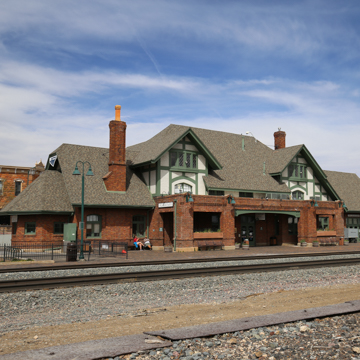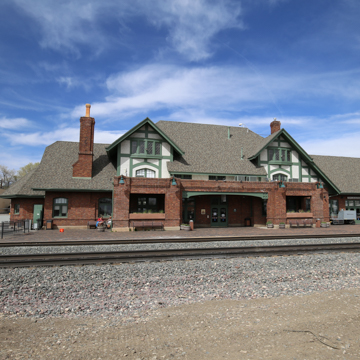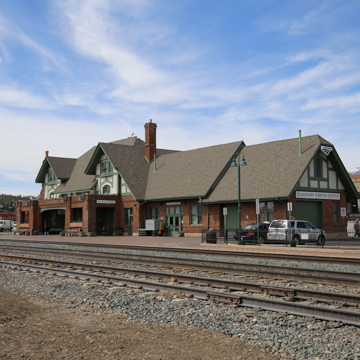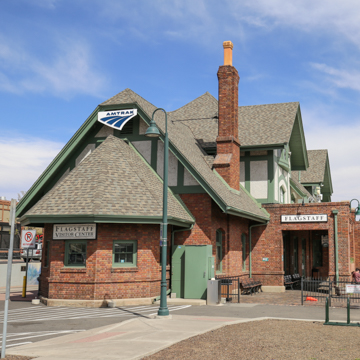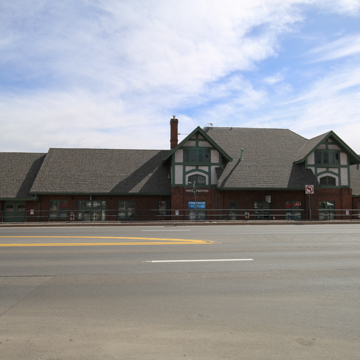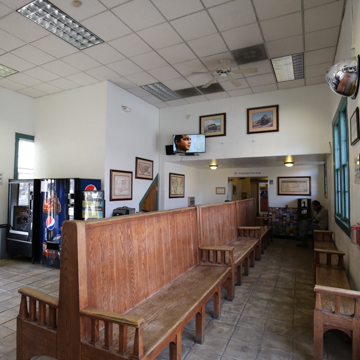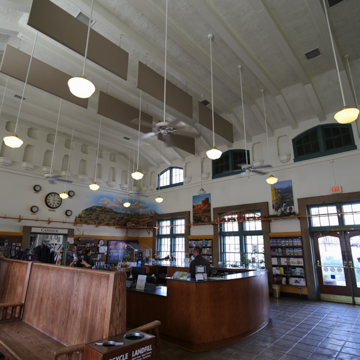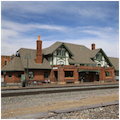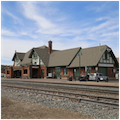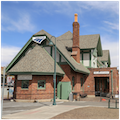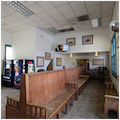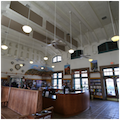You are here
Flagstaff Visitor Center and Amtrak Passenger Station
The former Atchison, Topeka and Santa Fe Railway (AT&SF) Depot is principally a testament to the railroad’s role in Flagstaff’s early development but it also became a landmark on the legendary transcontinental highway U.S. 66. The depot is noteworthy for its Tudor Revival architecture and the influence it exerted on local taste in buildings in the 1920s and 1930s.
The railroad shaped the city’s built environment almost from the outset, stimulating its growth, development patterns, and architectural character. Beginning in 1876 and following several earlier attempts at a permanent American settlement at Flagstaff, work crews building the transcontinental line for the Atlantic and Pacific Railroad (a predecessor of the AT&SF) established a camp at what became known as Old Town in 1880. The railway reached the area in 1882, but soon established “New Town” a half-mile to the east due to steep grades at the original settlement. Merchants gradually relocated around New Town’s makeshift depot (initially composed of interconnected boxcars), prompting the town’s commercial center to shift east as well. Flagstaff’s subsequent development followed the pattern of other nineteenth-century railroad towns; the depot was at the geographic center and streets were aligned parallel and perpendicular to the railway rather than the cardinal points. The town grew rapidly due to the railroad’s east-west expansion, and by 1886 Flagstaff was the largest urban area on the Atlantic and Pacific’s main line between Albuquerque and the west coast. In 1889, the railroad rebuilt the frame depot that had replaced the boxcars but was damaged in a fire using local red Moenkopi sandstone. This shift in materials signaled the town’s evolution towards more permanent and substantial structures. During the 1920s, Flagstaff’s business leaders sought to capitalize on the Grand Canyon’s new status as a national park by developing its tourist economy, including the community-sponsored Monte Vista hotel. In 1924 local residents succeeded in convincing the AT&SF that a new passenger depot was needed to ensure the town’s future prosperity, and the railroad planned a new facility one block west of the 1889 station (now containing offices), between San Francisco and Beaver streets.
Designed and constructed between 1924 and 1926 by the AT&SF engineering department, the depot assumed its predecessors’ role as the town’s urbanistic and architectural focal point. Asymmetrical in plan and massing, the two-story depot originally housed a baggage and express area in its east end, the general waiting room and agent’s office in the center section, and a women’s suite on the west, the latter corresponding to the large octagonal bay window on the exterior. A large brick porch facing the tracks sheltered waiting passengers.
The depot’s Tudor Revival design was a departure from the railway’s corporate architectural identity in the Southwest, epitomized by a series of iconic Mission Revival and Spanish Colonial Revival stations. The railroad apparently selected Tudor Revival because they felt it reflected the character of a mountain town, but it indeed extended the underlying Arts and Crafts theme of other company designs. Tudor Revival details include the tricolor brick walls in dark red, bright red, and orange; the steeply pitched cross-gabled roof with decorative half-timbering; the diamond-paned casement windows; and the tall corbelled chimneys. The waiting room reflects the character of the Tudor Revival exterior. Its two-story space resembles a medieval great hall with dark wood trim around the doors and windows and a series of niches and faux balconies recalling a minstrels’ gallery at the second-story level. It also has a vaulted beamed ceiling.
Alongside the general popularity of period revival styles in the United States during the 1920s and 1930s, the presence of the depot undoubtedly influenced Flagstaff builders to adopt the Tudor Revival in residential construction. This trend extended to the renovation of existing buildings as well as homeowners remodeling their houses by adding half-timbering and plastering brick walls. Ultimately, the Tudor Revival–period house supplanted the bungalow as the preferred local house type.
The depot formally opened in January 5, 1926, the same year that the government designated the federal highway U.S. 66. Passing directly in front of the depot building on Santa Fe Avenue, the highway—and the cars traveling on it—began to compete with the railroad for travelers through the region. Though the Flagstaff depot experienced a marked decline in transcontinental passenger train service, this was still one of the nation’s busiest rail corridors and it remained in use. In 1992, the city purchased the depot from the railroad and initiated a restoration program. Since 1994, the Amtrak waiting room occupies the old baggage area on the east side, while the Flagstaff Visitor Center uses the remainder of the building. The station remains in active passenger service as a stop for Amtrak’s Southwest Chief between Chicago and Los Angeles.
References
Garrison, James, Jody Gebhardt, and James Woodward, “Railroad Addition Historic District,” Coconino County, Arizona. National Register Places Inventory-Nomination Form, 1982. National Park Service, U.S. Department of the Interior, Washington, D.C.
Mangum, Richard K., and Sherry G. Mangum. Flagstaff Historic Walk: A Stroll Through Old Downtown. Flagstaff, AZ: Hexagon Press, 1993.
Paradis, Thomas. Theme Town: A Geography of Landscape and Community in Flagstaff, Arizona.New York: iUniverse, 2003.
Potter, Janet Greenstein. Great American Railroad Stations. New York: John Wiley and Sons, 1996.
Woodward, Jim, Deborah House, and Pat Stein, “Historic Resources of Flagstaff, Arizona,” Coconino Country, Arizona. National Register of Historic Places Inventory-Nomination Form, 1985. National Park Service, U.S. Department of the Interior, Washington, D.C.
Writing Credits
If SAH Archipedia has been useful to you, please consider supporting it.
SAH Archipedia tells the story of the United States through its buildings, landscapes, and cities. This freely available resource empowers the public with authoritative knowledge that deepens their understanding and appreciation of the built environment. But the Society of Architectural Historians, which created SAH Archipedia with University of Virginia Press, needs your support to maintain the high-caliber research, writing, photography, cartography, editing, design, and programming that make SAH Archipedia a trusted online resource available to all who value the history of place, heritage tourism, and learning.

